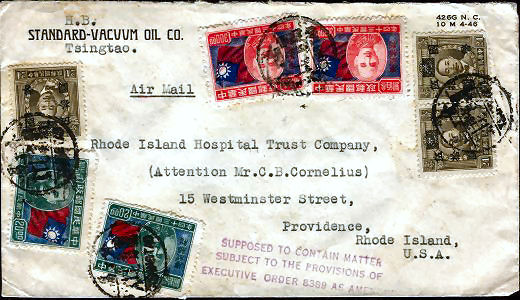![]()
Postal History Introduction
Stampless
Covers
1846
to 1900 Issues
1901-1950
Issues
1951-2003
Issues
Cancels
&
Miscellaneous
Postal
Stationery
Post
Cards
Air
Mail
First
Day &
Event Covers
Parcel Post/Special Delivery
Registered & Official Mail
Commercial & Advertising
Revenue & Postage Due
Wildlife & Game Issues
Complete List of RI Issues
|
Rhode Island Around the
World - International Mail |
|
|
|
|
This is a very interesting historical cover sent from Tsingtao, (Qingdao) China, a port city in Shantung Province. The letter was sent on a Standard-Vacuum Oil Company corner card to the Rhode Island Hospital Trust Company in Providence, Rhode Island (Attention to Mr. C. B. Cornelius). Although the date is unreadable in the cancellations, the 3 stamp issues that frank this cover place it as being sent in 1946. In addition, Japan occupied the city until 1945 and mail from Tsingtao would have been franked with occupation stamps until that time. The three olive-brown 21-cent definitive stamps were originally issued in 1941 as part of the "Revolutionary Martyrs" set, (Scott 415). They commemorate Chu Chi-hsin, an early member of the Kuomintang, (KMT). The 50.00 overprint with the surcharge box at top that is printed on these stamps was added in 1946. The other two stamp issues are both airmails from a set issued in 1946. They show a portrait of Shiang kai-Shek along with the Nationalist Chinese flag, ($20.00 - Scott 611 and $300.00 - Scott 614). The airmail stamps and the overprinted definitives were issued during an inflationary period. When the stamp was received at Providence, the Post Office added the Hand-Stamped text, "Supposed to contain matter subject to the provisions of Executive Order 8389 as amended." Executive Order 8389 of April 10, 1940 amended Executive Order 6560 dated January 15, 1934. This order regulated transactions in foreign exchange, transfers of credit and the export of coin and currency. The order was originally issued to prevent capital from leaving the United States. After the outbreak of World War II, President Roosevelt, on April 10, 1940 republished Executive Order 6560 as amended and renamed it Executive Order 8389. The law was originally intended to ban countries that had been overrun by the Germans, however it also applied to countries such as China that had been overrun by the Japanese. NOTE: I believe the application of this hand-stamp was applied in 1946 because of the Communist insurgency, which had by this time assumed control over large portions of the country. Since the letter was addressed to a banking institution and Executive Order 8389 was applied to the contents, it is evident that the contents had to do with transferring currency, credit or coins from the United States to China. Tsingtao, China is located on the Shantung Peninsula at the east entrance to Kiaochow Bay. Originally founded as a fishing village, by the 17th century Tsingtao had developed into a large trading port. Between 1889 and 1891, China established a Naval Station there, however in 1898 the Chinese government was forced to sign over Tsingtao and the surrounding bay to Germany; granting them a 99 year lease. Tsingtao was declared a Free Port in 1899. Japan entered World War I in 1914 on the side of the Allies for the express purpose of capturing Tsingtao from the Germans. Japan occupied the city until 1922, when it was returned to China. In 1929, the Kuomintang (Nationalist Chinese Government) gained control of the city, however in 1938 the Japanese recaptured the city, which they held until 1945. During the Japanese occupation considerable industrial development occurred. By 1949, Tsingtao had become a major base for heavy manufacture with textiles as the preeminent industry. In the late 1950s, a major steel and iron industry was established in the city. The Peoples Republic of China designated Tsingtao as an "Open City" in 1984, inviting foreign investment to the area. The city is home to 3 oceanographic institutes and is the center for the pursuit of marine science and technology. Tsingtao is also the site of the founding of one of the world's major religions, Taoism. The Rhode Island Hospital Trust Company was formed during the Civil War. State leaders agreed that Rhode Island needed a state hospital, and that the new institution should have an ongoing source of income. The Rhode Island Hospital was inaugurated in 1868 and the Rhode Island Hospital Trust (RIHT) was created to provide a source of income. Until 1999, it was the oldest trust company in New England, with over one third of it's profit initially dedicated to the Rhode Island Hospital. The hospital itself later became a major stockholder in the company. In 1916 the hospital became a partner in The Rhode Island Foundation and during the next 80 years the Rhode Island Hospital Trust's involvement with the hospital decreased as the new Foundation's staff and expertise grew. BankBoston absorbed Rhode Island Hospital Trust and then merged with Fleet Bank in 2000. |
![]()
RI Historical
Society
The Post Offices
Home Page
RI Tercentenary Issue History
RI Philatelic Society
Recently Added Pages
Philatelic Primer
Rhode Island Around the World
Rhode Island
Town Postmarks
Other Websites of Interest
Return to 1901-1950
Stamp Issues Part 2
OR
Return to RI
International
Mail Thumbnail Page Part 4
